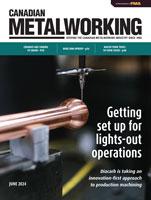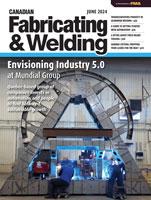Lead Engineer
- FMA
- The Fabricator
- FABTECH
- Canadian Metalworking
How to prep your laser for summer cutting
Tips to ensure optimal performance of lasers in the heat
- By Tom Eldin
- June 28, 2024
As the summer months arrive, temperatures naturally rise, creating a challenging environment for precision machinery, especially CNC lasers. These tools are integral to many manufacturing processes, where precision and reliability are paramount. However, the increased ambient temperatures during summer can compromise their operational efficiency and the quality of their output.
Understanding and undertaking proper maintenance of these systems, particularly the chiller units, is essential for sustaining peak performance and ensuring the longevity of your equipment.
Sensitive Tech
Lasers are highly sensitive to changes in temperature. The laser itself generates a considerable amount of heat during operation. Under normal conditions, this heat is effectively managed by cooling systems, primarily chillers, that help the laser and its components maintain a safe operating temperature. However, as ambient temperatures increase with the onset of summer, the stress on these cooling systems intensifies. Without adequate preparation and maintenance, the efficiency of the cooling system can degrade, leading to elevated operational temperatures.
Maintaining a dew point with lasers is critical, especially in the summer months. Dew point is the temperature at which water vapour in the air will condense into liquid. If liquid condenses onto optical elements like lenses and mirrors, it can cause scattering and absorption of laser light that will lead to inefficiencies and potential damage.
Be sure to set the water chiller’s operating temperature 2 to 3 degrees Celsius above the dew point but remain within the laser manufacturer’s specifications.
Fibre lasers are equipped with dew sensors that mitigate the risk by shutting the laser down. This could cause the laser to be down for several hours until the ambient temperature is stabilized.
Chiller Checkup
The chiller is the cornerstone of effective temperature management in CNC laser systems. It circulates a coolant to extract heat from the laser and dissipates it through a heat exchanger system. Before the summer heat sets in, it is crucial to conduct a comprehensive checkup of the chiller system. This maintenance should include several key actions.
- Measure factory water conductivity to reduce the corrosion of metal parts, which can degrade the laser system’s performance.
- Replace water at factory recommended intervals (typically every 12 months). This is critical with deionized water, which will become acidic due to its high affinity to absorb carbon dioxide (C02) from the air. Manufacturers often add anti-corrosion inhibitors during water changes to combat this.
- Change out filters at the same time you replace water. Dirty or clogged filters restrict flow, reducing the chiller’s ability to cool effectively.
Condenser Fins
Cleaning condenser fins is also important. Always start this process with the power switched off. Condenser fins should be vacuumed with a brush attachment. Often blowing condenser fins creates a lot of dust in the atmosphere, which is not recommended around fiber laser sources. In addition, filter matts should be replaced, and steel filter mats blown outside. Always wear an appropriate dust mask when performing this job.
Pro Tip: Use a condenser comb to straighten bent fins during maintenance. This is a key step to improve efficiency and longevity of your chiller.
Strainers and Leaks
A Y strainer mechanically removes solids and other particles when fluid flows through it. We often receive calls for chiller system blockages and find that the Y strainer is blocked. You can blow them out to achieve a temporary fix, but it is recommended to replace the strainer yearly with water changes.

We often receive calls for chiller system blockages and find that the Y strainer is blocked. You can blow them out to achieve a temporary fix, but it is recommended to replace the strainer yearly with water changes.
Inspect the chiller system for leaks. Even small leaks can lead to significant loss of coolant over time, which can drastically impact the cooling efficiency. Maintaining optimal operating temperatures enhances the quality of the laser's beam output. This is critical in industries where precision is key.
Adhering to a strict maintenance schedule for your CNC laser’s chiller system not only ensures zero unexpected downtime during the hot summer months, but it also extends the overall lifespan of your equipment. Routine preventive maintenance helps identify potential issues before they lead to major failures, saving costs related to repairs and downtime.
Tom Eldin is lead engineer at Laser Service Solution, Etobicoke, Ont., 647-618-3212, tom@laserservicesolution.com, laserservicesolution.com.
subscribe now


Keep up to date with the latest news, events, and technology for all things metal from our pair of monthly magazines written specifically for Canadian manufacturers!
Start Your Free SubscriptionAbout the Author
- Trending Articles
Focus on sustainable weld data collection for better results

Plasma cutting system increases cutting speed in 2-in. mild steel

How to prep your laser for summer cutting

AMADA CANADA hosts grand reopening of Quebec Satellite Center

Promotions announced at MC Machinery Systems

- Industry Events
IMTS 2024
- September 9 - 14, 2024
- Chicago, IL
WiM Summit 2024
- October 6 - 9, 2024
- Boston, MA
FABTECH 2024 Orlando
- October 15 - 17, 2024
- Orlando, FL
















